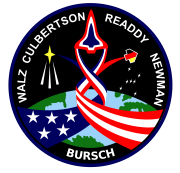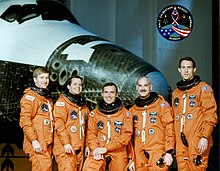
Back STS-51 Arabic STS-51 Bulgarian STS-51 Czech STS-51 Danish STS-51 German استیاس-۵۱ Persian STS-51 French STS-51 Galician STS-51 HE STS–51 Hungarian
 IMAX photography of Discovery in orbit, viewed from the free-flying SPAS-ORFEUS astronomy platform | |
| Names | Space Transportation System-51 |
|---|---|
| Mission type | Advanced Communications Technology Satellite (ACTS) satellite deployment Astronomy |
| Operator | NASA |
| COSPAR ID | 1993-058A |
| SATCAT no. | 22795 |
| Mission duration | 9 days, 20 hours, 11 minutes, 6 seconds (achieved) |
| Distance travelled | 6,608,628 km (4,106,411 mi) |
| Orbits completed | 157 |
| Spacecraft properties | |
| Spacecraft | Space Shuttle Discovery |
| Landing mass | 92,371 kg (203,643 lb) |
| Payload mass | 18,947 kg (41,771 lb) |
| Crew | |
| Crew size | 5 |
| Members | |
| Start of mission | |
| Launch date | September 12, 1993, 11:45:00 UTC |
| Launch site | Kennedy, LC-39B |
| Contractor | Rockwell International |
| End of mission | |
| Landing date | September 22, 1993, 07:56:06 UTC |
| Landing site | Kennedy, SLF Runway 15 |
| Orbital parameters | |
| Reference system | Geocentric orbit |
| Regime | Low Earth orbit |
| Perigee altitude | 300 km (190 mi) |
| Apogee altitude | 308 km (191 mi) |
| Inclination | 28.45° |
| Period | 90.60 minutes |
| Instruments | |
| |
 STS-51 mission patch  From left: Culbertson, Bursch, Walz, Readdy and Newman | |
STS-51 was a NASA Space Shuttle Discovery mission that launched the Advanced Communications Technology Satellite (ACTS) in September 1993. Discovery's 17th flight also featured the deployment and retrieval of the SPAS-ORFEUS satellite and its IMAX camera, which captured spectacular footage of Discovery in space. A spacewalk was also performed during the mission to evaluate tools and techniques for the STS-61 Hubble Space Telescope (HST) servicing mission later that year. STS-51 was the first shuttle mission to fly a Global Positioning System (GPS) receiver, a Trimble TANS Quadrex. It was mounted in an overhead window where limited field of view (FoV) and signal attenuation from the glass severely impacted receiver performance.[1] Full triple-redundant 3-string GPS would not happen until 14 years later with STS-118 in 2007.
- ^ "Analysis of the First Successful Flight of GPS Abroad the Space Shuttle". NAVAL POSTGRADUATE SCHOOL. Archived from the original on June 4, 2011. Retrieved November 17, 2009.